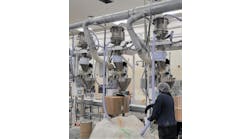Many problems in solids processing aren’t traceable to a specific piece of equipment or the procedures used to create the product. The culprits can be very elusive, especially when you’re trying to make a specific particle size distribution (PSD). It gets worse when your customers come out with a new specification. You just can’t change a temperature to get a new product in one piece of equipment as you can in a distillation column.
Often, the requested alteration is in the PSD. To make that change, you may have from one to four pieces of equipment in the process that you can use. The crystallizer is the most common piece of process equipment that can adjust the PSD. However, just altering the conditions in the crystallizer isn’t enough; that change must last through the solid/liquid separation and possibly a dryer, not to mention transport (conveying and packaging).
If your chemists have evaluated the crystallization process as I outlined in a past column “5 Alternatives to Conquer Crystallization Challenges,” you only may need to modify the crystallizer. For example, we made a product in a draft-tube crystallizer that used a fines destruction loop to control PSD. Changing the PSD was fairly straightforward. Luckily, our chemists pretty painlessly could evaluate different conditions and parameters. They did a series of small-scale test batches with various super-saturation levels to assess a variety of key parameters to get answers to some crucial questions:
• Average particle size. What are the mean size and overall PSD?
• Growth time. How long did it take to get to the above size?
• Metastable zone width. How super-saturated was the solution when crystals formed?
• Yield. How much solute did the isolated product contain?
• Product purity. How much of the solution ended up in the isolated product?
• Product shape. What did the crystals look like?
• Filterability. How easily did the crystals filter?
These tests showed little change in the product while altering the particle size. However, the various super-saturation levels provided enough information to modify the PSD in the draft-tube crystallizer. We then conducted more-comprehensive tests in a supplier’s pilot plant to determine the cut size for the fines destruction loop.
We weren’t as lucky with another product that was made in a forced-circulation device. The desired PSD required a new agglomeration step. We were able to perform it in the dryer — but not easily because doing process development in a production environment is messy. The plant did have another fluid bed that used a disperser to increase the average particle size and we were able to play on that experience. During development of that dryer, we found that we could mix fine particles from the dryer’s baghouse into the disperser to act as a pseudo-cement. That wouldn’t have been possible if the baghouse had been integrated into the dryer, which is a common design that can cause instability in the fluid bed.
Frequently, a customer will request a smaller product. While you might think achieving that would be a simple task, crystal shape is an important characteristic. Some chemicals don’t have the same reactivity when the shape is altered. A customer for a baking product we made wanted a much finer size because it improved the “mouth feel” of the product. Grinding the original product led to disappointing results. By going back to the experimental design parameters as outlined above, we found a set of conditions that not only produced a smaller particle but also gave an even better “mouth feel.” Having the experimental design parameters allowed us to offer this upgraded product and command a higher price.
One point about doing development in a plant: I worked with a company that had a policy in which engineers who designed a new plant or process ran it for a short period before the unit became commercial. This had the advantage of evaluating the fundamentals of the design in case a slightly different product was desired. It also helped in training operators and giving them a better feel for the process. The lessons were invaluable and allowed us to change the product, if needed.


